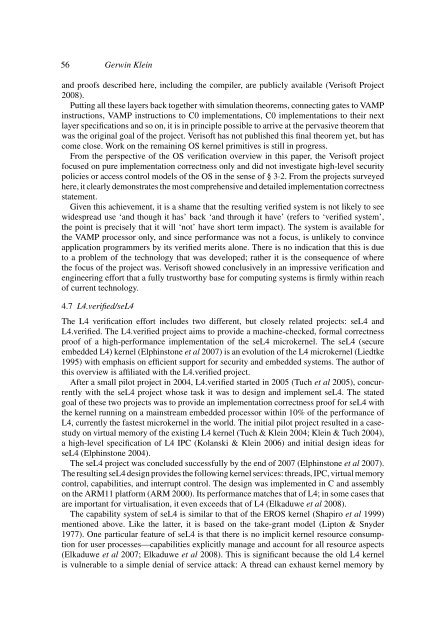Operating system verificationâAn overview
Operating system verificationâAn overview
Operating system verificationâAn overview
You also want an ePaper? Increase the reach of your titles
YUMPU automatically turns print PDFs into web optimized ePapers that Google loves.
56 Gerwin Klein<br />
and proofs described here, including the compiler, are publicly available (Verisoft Project<br />
2008).<br />
Putting all these layers back together with simulation theorems, connecting gates to VAMP<br />
instructions, VAMP instructions to C0 implementations, C0 implementations to their next<br />
layer specifications and so on, it is in principle possible to arrive at the pervasive theorem that<br />
was the original goal of the project. Verisoft has not published this final theorem yet, but has<br />
come close. Work on the remaining OS kernel primitives is still in progress.<br />
From the perspective of the OS verification <strong>overview</strong> in this paper, the Verisoft project<br />
focused on pure implementation correctness only and did not investigate high-level security<br />
policies or access control models of the OS in the sense of § 3·2. From the projects surveyed<br />
here, it clearly demonstrates the most comprehensive and detailed implementation correctness<br />
statement.<br />
Given this achievement, it is a shame that the resulting verified <strong>system</strong> is not likely to see<br />
widespread use ‘and though it has’ back ‘and through it have’ (refers to ‘verified <strong>system</strong>’,<br />
the point is precisely that it will ‘not’ have short term impact). The <strong>system</strong> is available for<br />
the VAMP processor only, and since performance was not a focus, is unlikely to convince<br />
application programmers by its verified merits alone. There is no indication that this is due<br />
to a problem of the technology that was developed; rather it is the consequence of where<br />
the focus of the project was. Verisoft showed conclusively in an impressive verification and<br />
engineering effort that a fully trustworthy base for computing <strong>system</strong>s is firmly within reach<br />
of current technology.<br />
4.7 L4.verified/seL4<br />
The L4 verification effort includes two different, but closely related projects: seL4 and<br />
L4.verified. The L4.verified project aims to provide a machine-checked, formal correctness<br />
proof of a high-performance implementation of the seL4 microkernel. The seL4 (secure<br />
embedded L4) kernel (Elphinstone et al 2007) is an evolution of the L4 microkernel (Liedtke<br />
1995) with emphasis on efficient support for security and embedded <strong>system</strong>s. The author of<br />
this <strong>overview</strong> is affiliated with the L4.verified project.<br />
After a small pilot project in 2004, L4.verified started in 2005 (Tuch et al 2005), concurrently<br />
with the seL4 project whose task it was to design and implement seL4. The stated<br />
goal of these two projects was to provide an implementation correctness proof for seL4 with<br />
the kernel running on a mainstream embedded processor within 10% of the performance of<br />
L4, currently the fastest microkernel in the world. The initial pilot project resulted in a casestudy<br />
on virtual memory of the existing L4 kernel (Tuch & Klein 2004; Klein & Tuch 2004),<br />
a high-level specification of L4 IPC (Kolanski & Klein 2006) and initial design ideas for<br />
seL4 (Elphinstone 2004).<br />
The seL4 project was concluded successfully by the end of 2007 (Elphinstone et al 2007).<br />
The resulting seL4 design provides the following kernel services: threads, IPC, virtual memory<br />
control, capabilities, and interrupt control. The design was implemented in C and assembly<br />
on the ARM11 platform (ARM 2000). Its performance matches that of L4; in some cases that<br />
are important for virtualisation, it even exceeds that of L4 (Elkaduwe et al 2008).<br />
The capability <strong>system</strong> of seL4 is similar to that of the EROS kernel (Shapiro et al 1999)<br />
mentioned above. Like the latter, it is based on the take-grant model (Lipton & Snyder<br />
1977). One particular feature of seL4 is that there is no implicit kernel resource consumption<br />
for user processes—capabilities explicitly manage and account for all resource aspects<br />
(Elkaduwe et al 2007; Elkaduwe et al 2008). This is significant because the old L4 kernel<br />
is vulnerable to a simple denial of service attack: A thread can exhaust kernel memory by
















